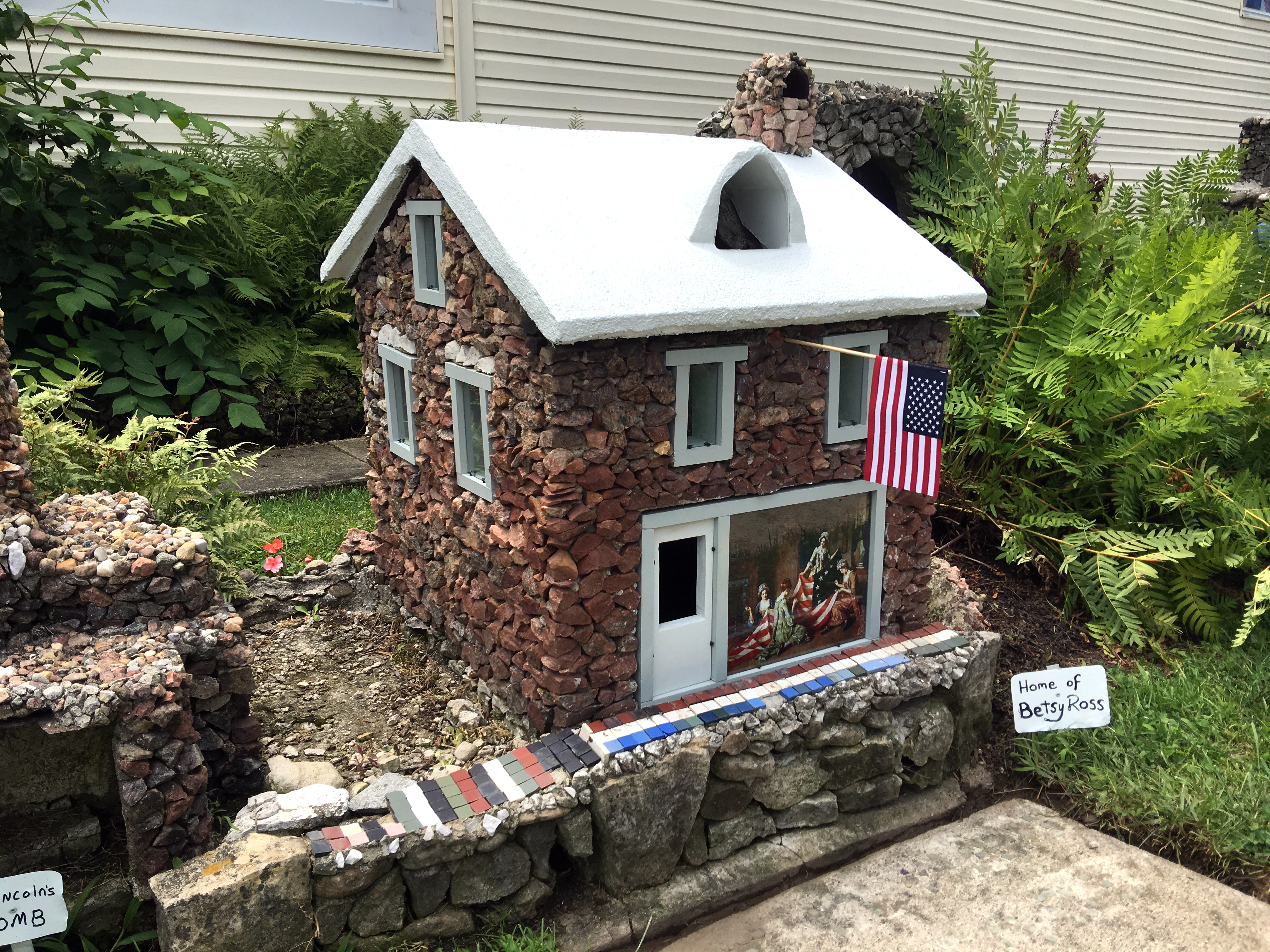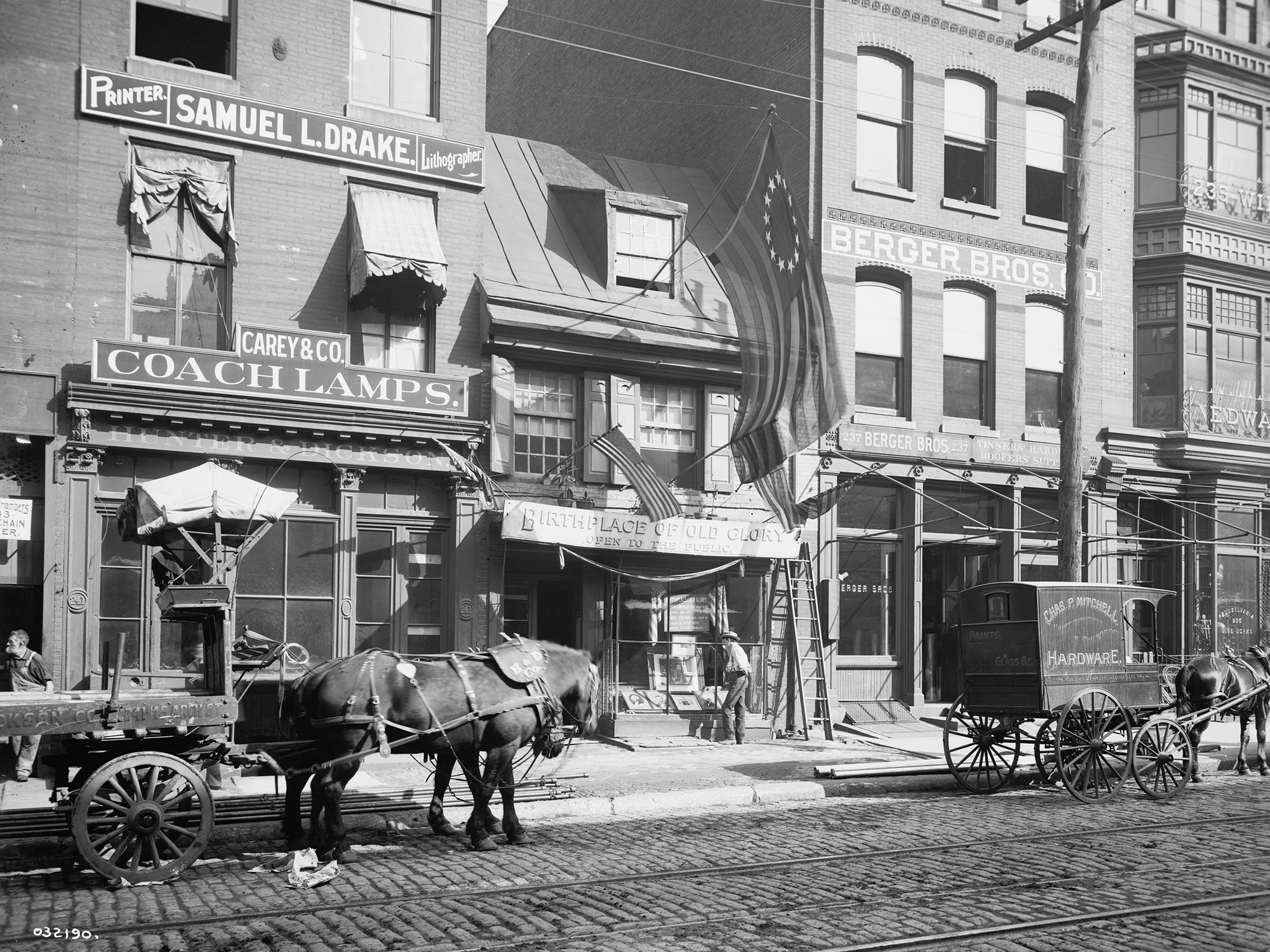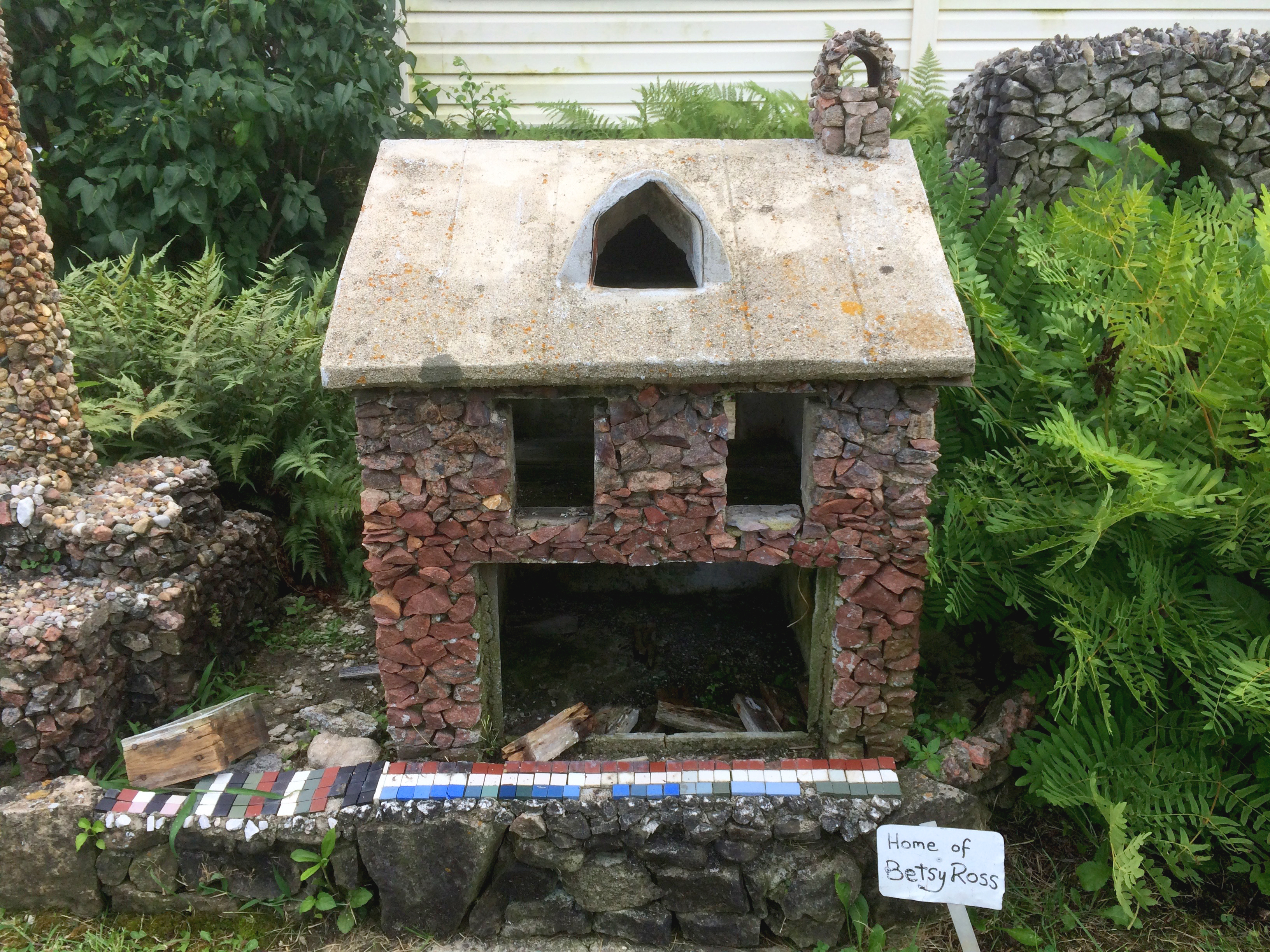BEN HARTMAN'S BETSY ROSS HOUSE
Ben Hartman’s representation of the Betsy Ross House is one of the garden’s most significant objects. It is also one of the best objects to illustrate his desires and ambitions for the garden. The miniature house was constructed in the fall of 1932, just months after work on the garden began. Along with the Liberty Bell and Lincoln’s Cabin, the house was one of his earliest patriotic objects, a key theme in Ben’s work. He modeled the house after the supposed home of Betsy Ross in Philadelphia. Popular history credits Ross with sewing the first American flag, per the request of George Washington himself, although debates regarding the authenticity of the story were common even then.

Betsy Ross House at the Hartman Rock Garden following the 2016 restoration (Photo by Kevin Rose)
In the late 1890s, the American Flag House and Betsy Ross Memorial Association raised money through a dime drive to restore and open the Philadelphia house as a museum. Paintings of Ross sewing the flag, along with popular accounts of her story in serials and other publications, propelled her to fame and helped draw thousands of visitors to her house each year. In 1932, the Ross House announced plans to restore the structure to its eighteenth century appearance, which was covered newspapers across the country, including the Springfield Daily News. That year also marked the bicentennial of the birth of George Washington, which caused a patriotic fervor that swept through the country. For the annual Flag Day celebration that June, Philadelphia’s Public Ledger ran a nationally syndicated piece on Betsy Ross, along with an image of her house and “The Birth of Old Glory” painting by Philadelphia’s own Clyde DeLand. It is possible that this article, or a similar piece, served as the inspiration and model for Ben.

Betsy Ross House in Philadelphia, circa 1895 (Library of Congress)
The Betsy Ross House at Hartman bears a strong resemblance to the 1932 version of the Philadelphia home, which had a front door on the left, a large picture window on the right, two windows on the second floor, and a dormer extending from the middle of the roof. The model at Hartman measures approximately 26.5 inches wide, 30 inches high, and 29 inches deep. Concrete forms the main structure, which is covered in a mixture of red granite and red quartzite. The red stone was intended to approximate the look of brick. On the top third of the house, the granite becomes noticeably more granulated. The variation of stone type and color also increases, giving a polychromic appearance to this upper level. While this could have been an artistic choice, it may have resulted from an inability to find enough solid color granite. The source of the stone is unknown, although it is likely that Ben picked it up in the nearby stream beds. On the side elevations, Ben capped the windows with a white stone. The roof is solid concrete poured over a sheet metal frame. To replicate the look of metal roof on the Philadelphia home, Ben drew vertical lines through the concrete. He also used metal, along with some glass, to frame the rough openings for the windows, which were covered by wood windows. None of the original windows survive due to wood rot.
Inside the wood windows, Ben held single-panes of glass in place with the use of two black tacks at the top and bottom. He cut a small wood door for the front and painted it white. In the picture window, he placed DeLand’s “The Birth of Old Glory” painting. This gave visitors the impression that they were looking in on the scene of Ross presenting her flag to George Washington, George Morris, and Colonial George Ross. The source of the image is unknown. Although DeLand was once well known for his patriotic paintings of colonial America, his Betsy Ross painting was rarely in print. The only known use was the aforementioned article from June 1932. However, due to the large size of the window, it is likely that Ben obtained his image from a still unknown magazine or calendar.
While the Betsy Ross House at Hartman bears a strong resemblance to the actual house in Philadelphia, it does deviate from the original in several ways. The original was a Philadelphia rowhouse, and, as such, did not have side windows. Ben’s model appears as a free standing home. When viewed from the front, it has three windows on the left side and two windows on the right. On the main façade, Ben’s second floor fenestration is symmetrical, whereas the windows on the original were offset to the left. The original attic dormer was rectangular, but Ben's model has an arched window. It also does not appear that it ever contained a glass window. In a 1937 restoration project of the original, the seeds of which were planted during the 1932 campaign, the association moved the doorway to the right side of the house and removed the large storefront window. As a result, the Hartman model now shares little resemblance with the present-day version of the Philadelphia house.
Since the object’s creation in 1932, it has undergone several alterations. The effects of moisture necessitated the replacement of the picture window image at an unknown date. The last known photo of the house taken during Ben’s lifetime, dated to 1939, shows a slightly-weathered Clyde DeLand image still in the window. This was replaced, possibly after Ben’s death in 1944, with an image of Henry Mosler’s painting “Birth of the Flag.” The original, owned by Georgetown University, was painted by Mosler in 1911.
After a successful crowd funding campaign, Ben Hartman's Betsy Ross House was restored in June 2015. Work was completed by the author, along with summer intern Caitlin Green, with guidance and training by Wisconsin-based Preservation Services. The concrete and stone were cleaned with Prosoco Enviro Klean 2010 All Purpose Cleaner. The windows and doors were rebuilt with yellow pine - the same wood that Ben used for his original windows - and were painted with Benjamin Moore Arborcoat paint. The roof was painted with Insl-X Aqua Lock Acrylic primer and Benjamin Moore Regal Select Exterior Acrylic Paint. All of the paints were donated by Brian Oliver and 800 Paint Place. As the Mosler painting sits against a glass window in a high moisture environment, the original treatment was not an appropriate option. Instead, Springfield-based Itinerant Studio printed the piece on stainless steel using UV resistant ink. Vicki Rulli and Tom Heaphey at Itinerant Studio generously donated their services and materials. The final element of the restoration was the return of the minature American flag, which once again waves proudly from the front of Ben's unique work of art.
A special thanks to Bob Swaney, whose generous donation made this project possible. I would also like to thank Caitlin Green, Brian Oliver, Vicki Rulli, Tom Heaphey, and Fernando Romero for their kind support and assistance.

The Betsy Ross House at the Hartman Rock Garden before restoration in 2015 (Photo by Kevin Rose)
CITATION: Kevin Rose, "Ben Hartman's Betsy Ross House: Object Study", Kevin Rose (blog), Turner Foundation, http://kevinrose.org/betsyross.html. Last accessed: September 11, 2020.